
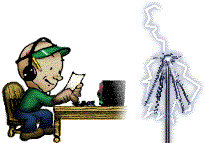
If you cannot see the full index shown on the left edge of your screen, please go to my main page at
If you are from a Country that has adopted the CEPT agreement then your callsign will be your own prefixed by 'M' for example F6ABC would, in England, operate as M/F6ABC or would adopt the other UK Country identifiers i.e.
M = England
MM = Scotland
MI = Northern Ireland
MJ = Jersey
MU = Guernsey
MD = Isle of Man
MW = Wales
Throughout the United Kingdom Amateur Radio activity can always be found on 2 metres (145 MHz) FM. The UK 2 metre band allocation is from 144-146 MHz and does not extend to 148 MHz as is the case in the USA. Simplex FM only channels are from 145.2125 up to 145. 5875 MHz. Channel spacing is 12.5 kHz. The simplex calling frequency is 145.500 MHz. Repeaters channels are from 145.600 up to 145.7875 MHz with a repeater offset of minus -600 kHz.
Although simplex is in regular use, the amateur radio repeaters are extensively used too and you are more likely to receive an answer to your call by trying there first. UK repeaters are initially accessed either by the use of a 1750 Hz tone burst and/or a CTCSS sub-audible tone, which varies depending on which part of the UK you are in.
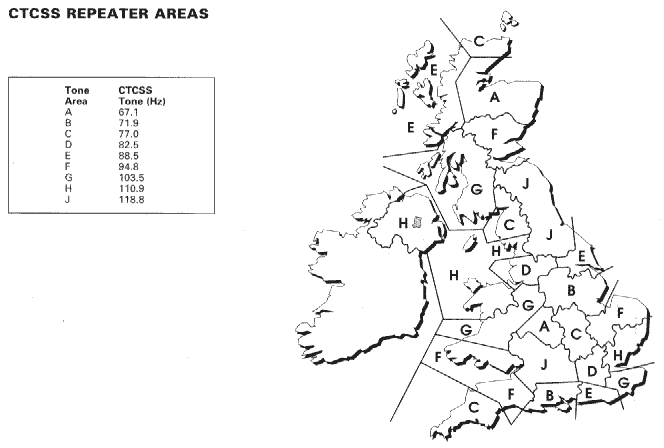
If you do not have a 1750 Hz tone it is possible to whistle such a tone by starting with a low note and stopping at a higher note. Once the repeater is activated by the use of the tone or CTCSS they also require some speech audio. Repeaters generally have a time-out feature of anywhere between 2 to 5 minutes i.e. you can only transmit for this period of time before releasing your PTT or the repeater will shut down. After you have released the PTT the repeater will transmit a morse K or E to signify it is the turn of another amateur to transmit. The repeaters will shut themselves down after a period of no use.
Repeater etiquette is that mobile stations have priority and then fixed stations. If the repeater is not in use then feel free to call through. In general UK amateur radio is free from abuse and pirates, but occasionally suffers with large urban cities having the most problems.
Also in the UK the 70 cms (432 MHz) band has excellent repeater coverage. Simplex FM from 433.400 MHz to 433.575 MHz, with 25 kHz channel steps, simplex calling frequency being 433.500 MHz. Repeaters are from 433.000 to 433. 375 MHz, with a repeater offset of plus +1.6 MHz.
Visiting radio amateurs usually always receive replies to their CQ calls, as UK amateurs enjoy speaking to people from different Countries who are visiting. Many UK amateur radio clubs will welcome visitors too.
To make the process of using your radio equipment easier in the UK, some radios have external software programmes to make editing your memories and frequencies much easier. Try to find your radio on the Yahoo Groups pages, where you will often find files containing the entire frequencies for a particular Country. Simply download the file, transfer it into your radio and you are ready to operate.
I have already created files for the UK for the following handheld radios: Kenwood TH-F7/F6, Kenwood TH-D7, Yaesu VX-2R.
If you have 'Microsoft Autoroute 2002' or similar you can download and save the following 'Excel' file which contains all the UK 2m & 70cm repeater details, then using the 'import data wizard' function within MS AR you can have displayed the repeater locations, frequencies, CTCSS etc. on all your route maps. Right click then 'Save target as' AR repeaters

|
Useful links for your holiday overseas |
||
|
|
||
|
|
||
It can be fun operating abroad with your amateur radio equipment; speaking to the local radio hams and back home to the UK, or indeed around the World. I have found that taking a handheld radio is a minimum requirement, and in Europe most of the frequency bands for 144MHz FM operation are similar. On 432MHz FM there can be quite a few differences particularly with repeater splits and frequencies. Make sure before you travel that you look up the frequency allocations for the Country/s you intend to operate in.
Outside of Europe this is even more important. The USA for example operates on 5 kHz channel steps on their 2m FM band, we use 12.5 kHz steps, and instead of our 144-146MHz allocation, they have 144-148MHz. Will your existing radio operate there on their frequencies and with their channel steps? If it won't then it might be easier to buy a cheap handheld whilst you are there. Always have a look at the local national amateur radio society for further information i.e. for the USA that would be the American Radio Relay League HQ, for Spain the Union Radioaficionados Espanoles (URE), etc.
Map of VHF 144 MHz Amateur Radio Repeaters in Spain
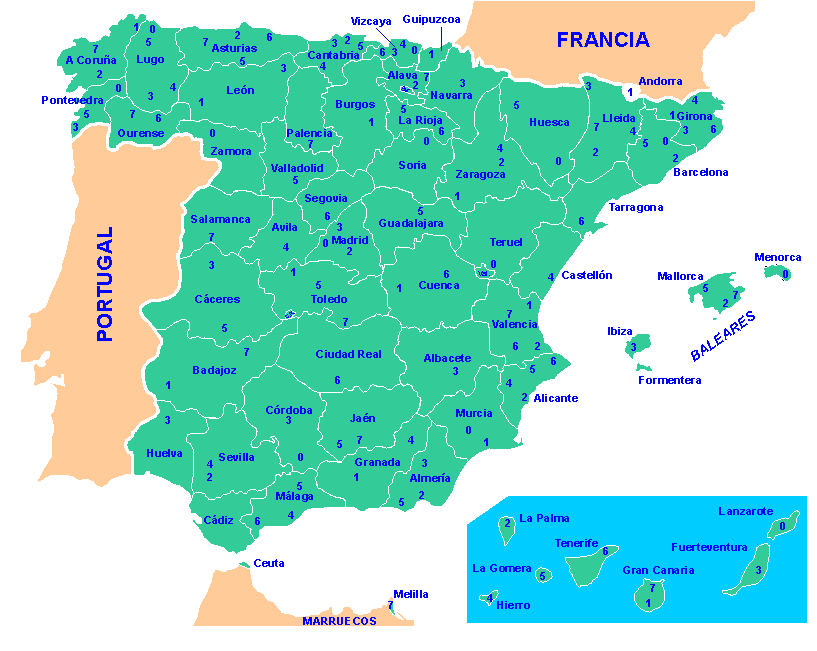
Map of UHF 432 MHz Amateur Radio Repeaters in Spain
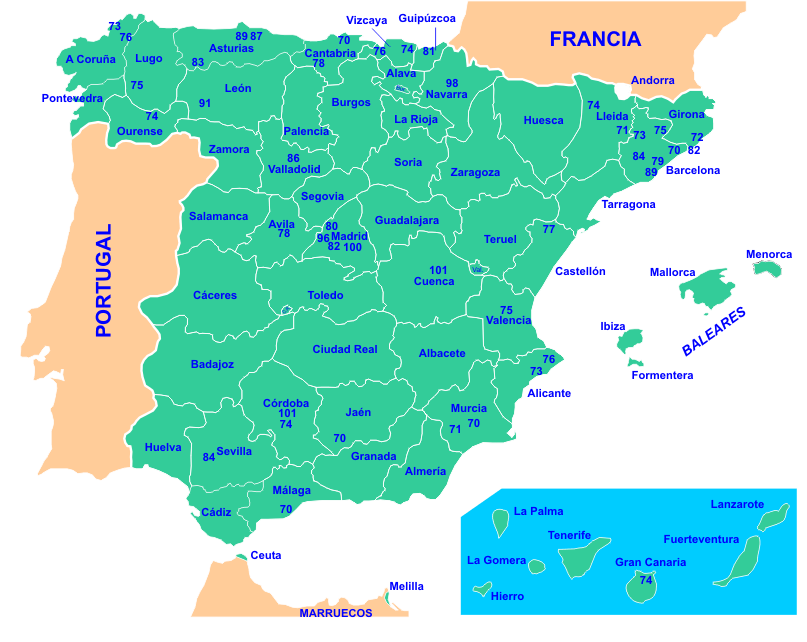
Make sure that you take with you your current amateur radio licence and BR68. It will also be very wise to take a translation of your Amateur Radio licence, in the language of the Country you are visiting, this is in case you are stopped by the Police and language barriers prevent them from reading your radio documents. The CEPT agreement makes operation overseas in a lot of other Countries straightforward, but if the Country you are travelling to isn't signed up to CEPT then you may have to apply for a reciprocal licence. Remember that whichever operating frequencies are the more restrictive, either your own or the host Countries, that is the band plan that you must adhere too i.e. not all Countries have a 50MHz allocation, not all Countries have an extended 40m band above 7.100 MHz.
Callsigns generally remain your own with the prefix of the Country you are in. Examples of call signs I have used are: EA6/G0ISW (Majorca island, Spain), 5B4/G0ISW (Cyprus), F/G0ISW (France), EI/G0ISW (Republic of Ireland) etc. If you live normally in a UK Country with a Secondary prefix character such as GW, GI, GM, GJ etc. then you retain that abroad for example F/GW0ABC and do not drop the secondary prefix letter such as F/G0ABC. There was some confusion about this in early 2007, which was then clarified by OFCOM. Please not as of 2024 OFCOM have dropped the UK requirement for secondary prefixes in the UK, I do not know about operating abroad.
To make the process of using your radio equipment easier abroad, some radios have external software programmes to make editing your memories and frequencies much easier. Try to find your radio on the Yahoo Groups pages, where you will often find files containing the entire frequencies for a particular Country. Simply download the file, transfer it into your radio and you are ready to operate.
I have already created files for the UK for the following handheld radios: Kenwood TH-F7/F6, Kenwood TH-D7, Yaesu VX-2R.
I have historically tried operating abroad taking with me large HF/50 MHz radios, such as a Kenwood TS-690SAT, 14MHz Zeppelin aerial and associated heavy duty power supply, but it just takes up too much room as hand luggage to be convenient. In more recent years I have drastically reduced the radio size to a very manageable one by changing to my Yaesu FT-817 and Miracle whip aerial.
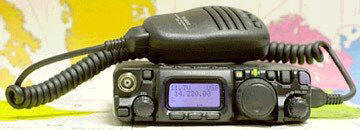
Despite only having 5 watts maximum output I have managed to easily work around Europe on HF from French and Scottish beaches and even the USA. My furthest contact being with Venezuela on 14MHz SSB speech. The advantage of the Yaesu FT-817 is that it also covers my favourite VHF/UHF bands so working 50MHz locator squares via Sporadic E is simple too, in June.
For urban locations or when I want to travel really light I have used the Yaesu VX-1R which is truly pocket sized and incredibly light, or my Kenwood TH-F7 offers rather more output and has a DTMF keyboard for use with EchoLink nodes. The EchoLink facility allows you the opportunity to speak with other radio amateurs around the World, very conveniently.
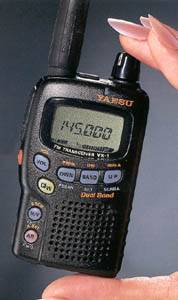
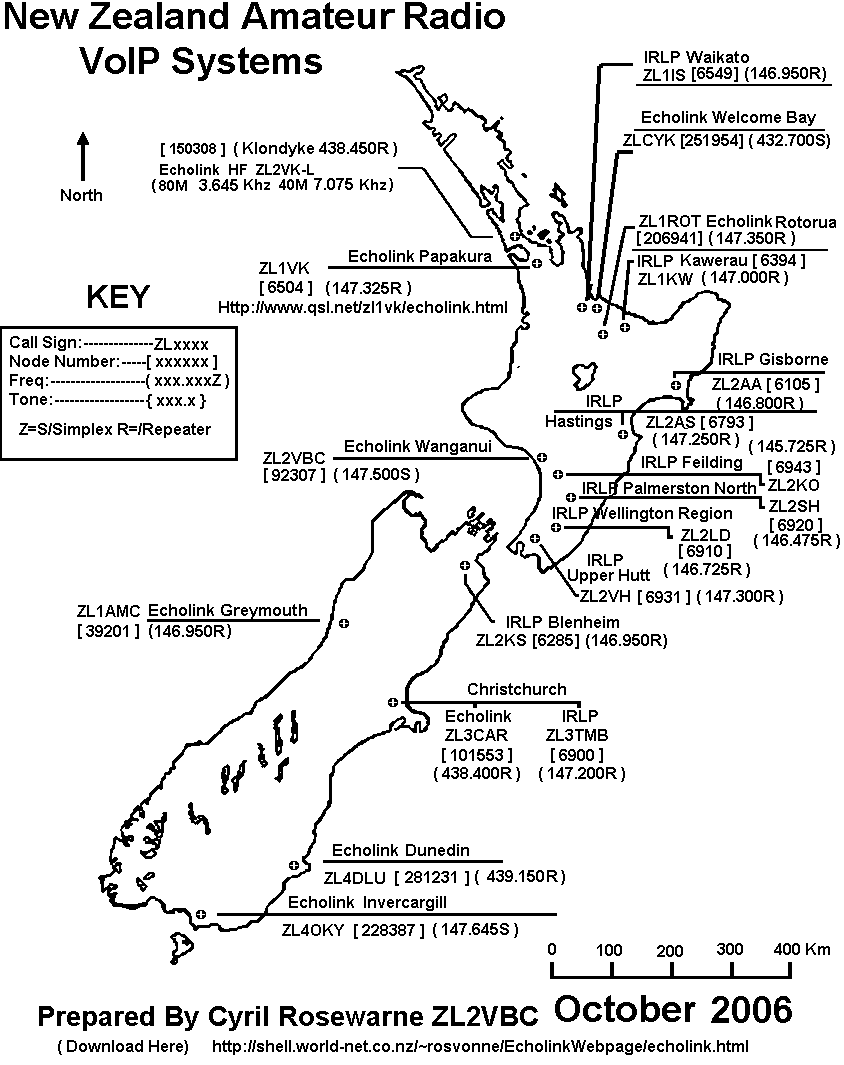
|
|
|
||
|
|
Send formatted VHF DX Cluster spot |
|
|
|
If you cannot see the full index shown on the left edge of your screen, please go to my main page at © Copyright G0ISW. Page last modified October 2024. All Rights Reserved. |
|||